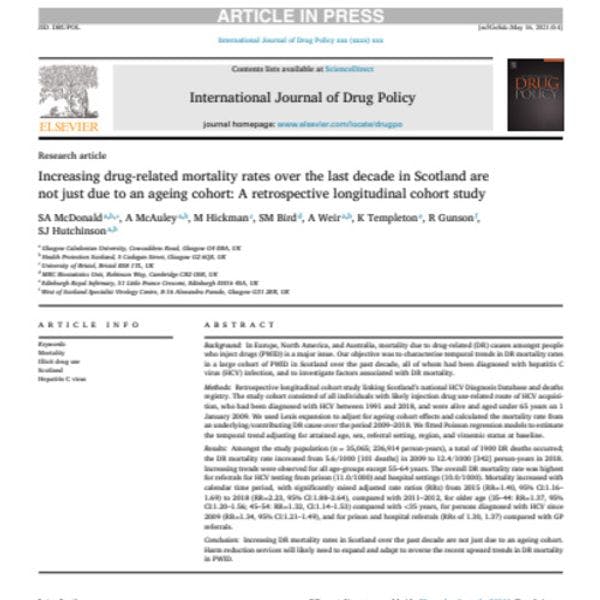International Journal of Drug Policy
Increasing drug-related mortality rates over the last decade in Scotland are not just due to an ageing cohort: A retrospective longitudinal cohort study
By SA McDonald et al.
Of the four nations of the UK, Scotland had the highest population- level drug-related (DR) mortality rate in 2018 of 29.8 per 100,000 – about four times the drug poisoning mortality rate for England and Wales in 2018 (ONS, 2020) – which is potentially the highest DR mor- tality rate in the European Union (NRS, 2019), and one of the highest DR mortality rates worldwide (Degenhardt et al., 2011). Trends in an- nual deaths suggest that the situation has become markedly worse in the last few years. In Scotland the annual number of drug‐related deaths doubled between 2008 and 2018 from 474 to 1187, with a 27% rise ob- served between 2017 and 2018 (NRS, 2019). Both the magnitude of, and the observed increasing trend in, DR mortality rates constitute a public health crisis for Scotland (Nicholls et al., 2019).
Between 2001 and 2011, decreased DR mortality rates have been re- ported for males aged 15–29 years; however, rates increased in the 30– 44 year age-group (Brown, Allik, Dundas, & Leyland, 2019) – this sug- gests that the raised DR rates in later years might simply reflect a cohort of drug users becoming older, with cumulative risk behaviours and/or worsening health with age leading to premature mortality (Pierce, Bird, Hickman, & Millar, 2015) – an ’ageing cohort effect’. However, other ex- planations are possible, such as evolving drug choices amongst current users over time (for instance, changing patterns of polydrug use, such as illicit benzodiazepines in combination with heroin, or an increase in injecting relative to other modes of administration, as seen for e.g., co- caine), austerity (which impacts on provision of addiction treatment), homelessness, and (less plausibly) a changing age distribution of new users. It is therefore of importance to distinguish an ageing cohort from other possible drivers of an increasing DR mortality trend (House of Commons, 2019).
The principal objective of our study was to investigate temporal trends in DR mortality rates amongst people who inject drugs (PWID) in Scotland over the past decade (2009–2018), and to quantify associa- tions between DR mortality and factors such as age, sex, and region. We utilised the record linkage of data on individuals diagnosed with hep- atitis C virus (HCV) – a condition predominantly affecting those who inject drugs in Scotland and associated with a two-fold increased DR mortality risk (Merrall, Bird, & Hutchinson, 2012) – to examine trends in DR mortality amongst PWID diagnosed with this infection. Studying DR mortality amongst Scotland’s HCV-diagnosed cohort has the advan- tage of providing a suitable denominator to permit age and time effects on mortality rates to be distinguished, and also helps understand and improve the initiatives of Scotland’s HCV Action Plan to co-locate HCV testing and management with drug addiction services (Hutchinson et al., 2015).
Downloads
Regions
Related Profiles
- International Journal of Drug Policy
